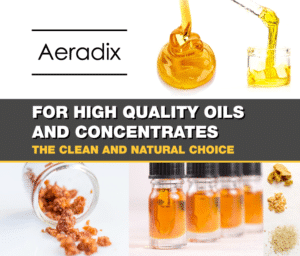Many cannabis producers have moved beyond using solvent extractions to isolate cannabinoids and other desirable compounds from cannabis plants. However, there are still plenty of concentrate products available that involve the use of hydrocarbons—such as butane and propane—ethanol, or carbon dioxide to pull THC, CBD, terpenes, and more from raw cannabis plants.
While efforts are made to remove these solvents, it’s likely that some amount will end up in the final product. In regulated markets, there are specified levels of solvents that are allowed in products sold or prescribed to consumers. This article was adapted from Leafly.com and looks at ways to minimise your risk in South Africa.
Products that are not regulated, such as those sold illicitly, are not tested for residual solvents or whether the solvents used are safe at all. Therefore, it’s always important to get your cannabis products from a legal, licensed store.
Consuming high levels of solvents could pose health risks, some of which aren’t entirely established.
Health implications of ingesting common solvents
The main solvents used in cannabis extraction are carbon dioxide, butane, and ethanol. Extracts are most often vaporised, via a vape pen or dabbing, but they can also be incorporated into edibles. Less commonly, extracts are smoked, for example by topping a bowl with wax or dipping a joint in concentrate.
Luckily, residual carbon dioxide is not a concern. However, depending on levels and method of consumption, excess butane or ethanol could pose health risks.
Butane
Butane offers a relatively simple and inexpensive method to extract a large percentage of THC and other desirable compounds from cannabis plants. But it has been the subject of much controversy when it comes to what is considered a safe amount. Long-term consumption of butane has not been studied widely enough to confidently say it’s safe at any level.
Regulators appear to disagree and in many regions, butane is allowed at the seemingly high level of 5 000 ppm. However, illegal or home-made products could contain much higher levels.
Butane inhalation can cause cardiac damage and organ failure, among other serious negative effects. The risks are associated with direct inhalation of the solvent rather than practices such as dabbing. Dabbing butane hash oil (BHO) products may still be harmful to health.
A 2019 study investigating an 18-year-old’s lung injury that resulted from frequent and prolonged inhalation of (BHO) had a scary conclusion found: “There is a likely probability that a high level of inhaled butane also contributed to her symptoms.”
It should be noted that in this case, the patient confirmed that the butane hash oil was purchased illegally. This indicates that the product contained an unknown level of butane. A level which could have been well above what should be allowed in a regulated product.
Ethanol
In California, the maximum level of ethanol allowed is 1 000 ppm for medical cannabis goods meant for inhalation. However, 5 000 ppm is the maximum level for other medical cannabis-infused goods. Ingesting ethanol in these small amounts is unlikely to cause harm, even over a prolonged period.
A 2018 report (involving multiple studies conducted on animal or human subjects) found that ethanol inhalation could be more risky, potentially causing cravings, tolerance, and dependence. However, studies tend to examine levels of ethanol exposure far higher than you would ever find in vape oil.
Other solvents
Some other potentially harmful solvents end up in cannabis products because they are contaminants of the main Class 3 solvents used in extraction or because they are used to clean equipment used in the production process.
Here are a few that may find their way into a final product:
- Benzene: This is a known carcinogen that affects bone marrow.
- Xylenes: In vaporized form, xylenes can cause depression of the central nervous system. Depending on the level of exposure of these Class 2 solvents, symptoms can include nausea, headache, dizziness, and vomiting, among other symptoms.
- Hexane: This Class 2 solvent can have similar effects as xylenes on the central nervous system if inhaled at high enough levels. Cyclohexane is used in 99.9% ethanol (absolute) to remove water.
The safest approach to solvents
Using food grade ethanol is by far the safest way to make cannabis concentrates with solvents. However, it is possible to make safe concentrates when using a still or a thorough evaporation process. The solvent used should still be a good alternative that does not contain acutely harmful substances. A denatured ethanol substitute, like Herbal Extraction Solvent is the best alternative to food grade ethanol.

